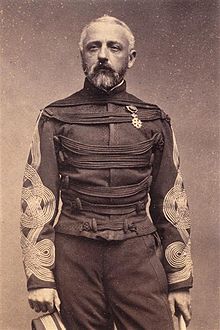Austrian knot
This article needs additional citations for verification. (April 2017) |

An Austrian knot (or Tyrolean knot) is an elaborate design of twisted cord or lace worn as part of a dress uniform, usually on the lower sleeve. It is usually a distinction worn by officers; the major exception is the hussars, in which Austrian knots are worn by all ranks. British cadet under officers wear Austrian knots as part of their rank insignia.
History
While of Hungarian origin "Vitézkötés", in English "Warrior's knot", the "Austrian knot" evolved as an indicator of rank among hussar officers of the Austrian (later Austro-Hungarian) Army in the 18th century. Epaulettes were widely perceived amongst the government in Vienna as a foreign influence (due to their French origin) and thus not acceptable for the Austrian armies. In the hussar regiments ranks came to be denoted by braided gold cords on the sleeve, with the number of gold cords representing the rank of the officer. Other branches of the Austrian Army used a system of waist-sashes and collar stars to distinguish commissioned rank.
Austrian knots soon appeared as part of the distinctive dress of hussar regiments in the armies of other European nations but did not gain wider popularity until the last decades of the nineteenth century, when many colonial officers began wearing them (including British infantry officers of the Anglo-Zulu Wars). British officers of most regiments wore Austrian knots of a simplified pattern in gold braid on the cuffs of their full dress tunics[1] until this order of uniform ceased to be generally worn after 1914.
Along with most other elaborate and conspicuous indicators of rank, Austrian knots fell into disuse during the First World War and were not revived in everyday wear. An exception was the French Army where the kepis still worn by most officers have Austrian knots in cruciform pattern on the top crown. French officers of North African regiments such as the Zouaves and the Algerian Tirailleurs continued to wear Austrian knots in gold braid on the sleeves of their colourful full dress uniforms until 1939. They are still worn on some parade uniforms in France, where they are called noeuds hongrois ("Hungarian knots").
United States usage
During the American Civil War, Confederate officers often wore gold Austrian knots on their uniforms. More elaborate braiding indicated higher rank. This type of insignia was worn by officers of the US Army on the sleeves of the blue full dress uniforms authorised until 1917. It is a feature of the blue mess dress uniform adopted as optional wear for officers in 1937 and still worn for formal social or evening functions.
Notes
- ^ Encyclopædia Britannica, Eleventh Edition, page 585, Vol. 27

